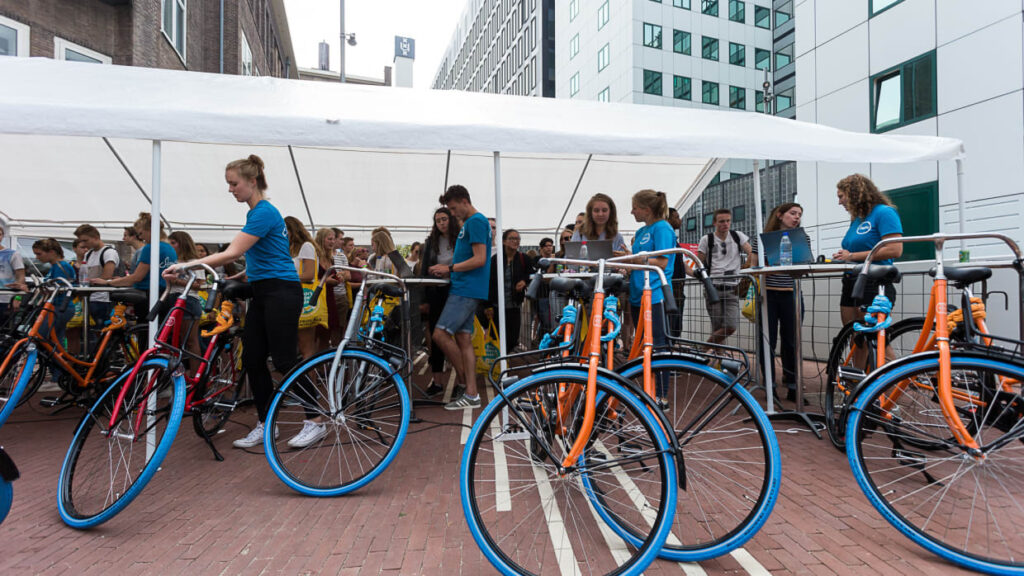You’ve probably seen them whizzing by: the Swapfiets bikes with the distinctive blue front wheels. In a short time, Swapfiets, a subscription model for bikes, grew from a student project into a thriving organization with 1,400 employees. But there was no ERP system yet. With the help of implementation partner Aiden, Swapfiets turned things around. They shared their story during the SAP S/4HANA Public Cloud Innovation Day in ‘s-Hertogenbosch.
Swapfiets began as a small-scale initiative by three Dutch students. The idea was simple: a subscription model for bicycles. Instead of buying a bike, members could use a bike of their choice for a fixed monthly fee through Swapfiets. The initiative turned out to be a hit. Today, Swapfiets has 270,000 members spread across eight countries. In case of problems, Swapfiets repairs or replaces the rental bike within 48 hours, ensuring members can quickly get back on the road.
Growth without ERP
Swapfiets grew rapidly over the years, but automation lagged. The company managed its operations without an ERP system, relying on Excel and self-developed systems, leading to a lack of overview and efficiency. This became unsustainable as the company grew. By then, Swapfiets had 1,400 employees, 18 warehouses, and 60 stores, performing 135,000 repairs annually. They had 7.3 million euros in spare parts but no system to properly manage the inventory.
The standardization and flexibility of SAP S/4HANA
“And so we faced a great challenge,” recalls Clémence Grillon, Head of Warehouse and Repair Operations & Global Manager Operational Excellence at Swapfiets. Grillon was astounded when she learned that Swapfiets had been operating without an ERP system all those years. “We had to get to work. A digital transformation was necessary, and we chose SAP S/4HANA Cloud Public Edition. It felt like a logical choice for us. Swapfiets needed a system that could be implemented quickly and offered best practices. SAP S/4HANA Cloud provided us with the necessary standardization and flexibility.”
Swapfiets opted for a phased approach to the migration, starting with the automation of the most crucial part of the organization: the management of spare parts. “This aspect had the greatest impact on our daily operations,” Grillon explains.
Ready-to-run approach
ERP was new for Swapfiets, but also for all users. Clemence saw not only the challenge of implementing ERP but also the need to guide users for smooth adoption. “For this reason, we consciously chose to start with repair and scale up. Additionally, the ready-to-run approach of SAP S/4HANA Cloud played a significant role.”
Grillon describes how Swapfiets transformed step by step. “We started with the purchasing side, the process from our suppliers to our central warehouses. In January 2023, we began implementing this. Once that was done and everything was live, we moved on to the second phase, which was the processes between our central warehouse and the stores. We rolled out the pilot in November and shortly after, we could also celebrate a successful go-live for this phase.”
“Aiden was indispensable to us”
Aiden, a regular SAP partner, handled the implementation of SAP S/4HANA Cloud Public Edition at Swapfiets. According to Grillon, Aiden’s help in this process was indispensable. “One of our key lessons learned from this digital transformation is that the right partner is crucial. We are a young company without experience in this area. You need a partner who guides you and advises you. Aiden told us exactly what we should do and why they recommended it. That was very helpful.”
From chaos to control
Grillon now looks back with a smile on the period when Swapfiets operated without an ERP system. “All important information was in emails or various Excel files. There was no overview at all. From a situation where we had no insight into the status of our supply chain and warehouses, we have now moved to a situation where we have exact information at any moment. And from chaotic purchasing, we have moved to a coherent system.”
“We now know what we have, what we pay, and what we order. This gives us full control over our purchasing and inventory,” says Grillon. “The next step is to also integrate our Bikes and Batteries division into SAP. Hopefully, we can achieve that by the end of 2024. Swapfiets has quickly transformed into SAP-fiets for us.”
Are you curious about how SAP S/4HANA Cloud Public Edition can help your SME? Please contact SAP or one of our partners.
